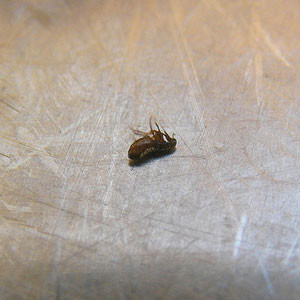Preparing for a Flea Treatment
By Chris Williams on September 9, 2013.

Question
We’ve had our home professionally treated for fleas before but it doesn’t seem to work very well. Seems like in just a couple of weeks, we’re seeing fleas again. Is this normal?
Answer
It’s not normal. Maybe you need to try a different pest management company. Flea control, however, involves more than just treatment of your home. Your pest control company should have advised you to make sure your pet was treated as well. That’s essential. A pesticide treatment of your home will kill the immature larval fleas that are in carpets and pet resting areas, but will not affect the adult fleas that are on your pet. If you don’t kill the adult fleas, they will just lay more eggs and the cycle will continue. There are also steps that you can take before a professional treatment that will enable the technician to do a more complete and effective treatment.
Preparing for a Professional Flea Treatment
- Pick up children’s toys, pet dishes, pillows, and other loose objects from floors. Gather up pet blankets and other pet bedding. Discard old bedding or wash it in hot water.
- Thoroughly vacuum your entire home—carpeting, hardwood floors, under chairs, sofas, and beds—before the technician arrives. Place the vacuum bag inside a sealed plastic bag and discard it. Don’t vacuum immediately after the treatment.
- If you won’t be home, tape sheets of paper to your pet’s favorite chair, or corner of the family room, or other places where he sleeps, with the words, “Pet Rests Here.” It’s important that these pet resting areas get treated because that’s where developing flea larvae are most likely to be found.
- Sometimes pets bring in new fleas from outside to reinfest the home. If your yard is also to be treated for fleas, pick up toys, pet bowls, wading pools, and lawn furniture. Clear porches, patios, and decks. Clean dog houses and kennels and discard bedding. Mow and water the lawn before treatment, not immediately afterwards.